外研版(2019)选择性必修第二册Unit 3Times change! Developing ideas Emojis_a new language课件 (20张ppt)
文档属性
| 名称 | 外研版(2019)选择性必修第二册Unit 3Times change! Developing ideas Emojis_a new language课件 (20张ppt) | 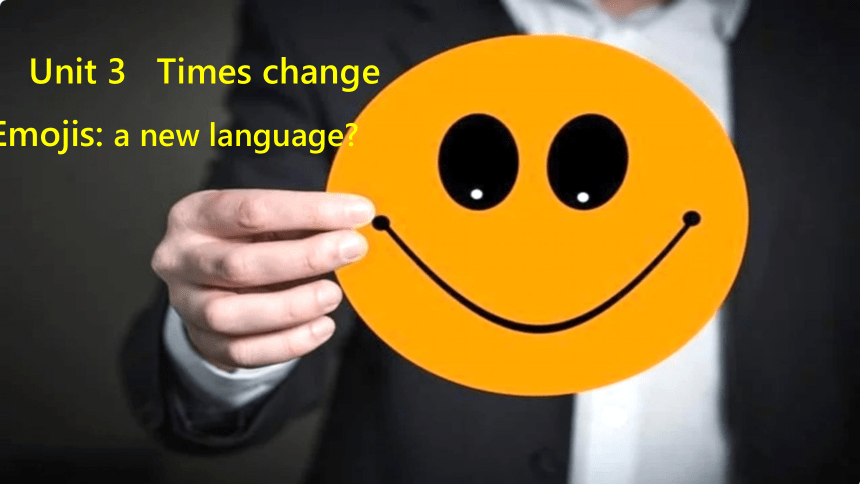 | |
| 格式 | zip | ||
| 文件大小 | 1.5MB | ||
| 资源类型 | 教案 | ||
| 版本资源 | 外研版(2019) | ||
| 科目 | 英语 | ||
| 更新时间 | 2022-07-05 20:36:04 | ||
图片预览

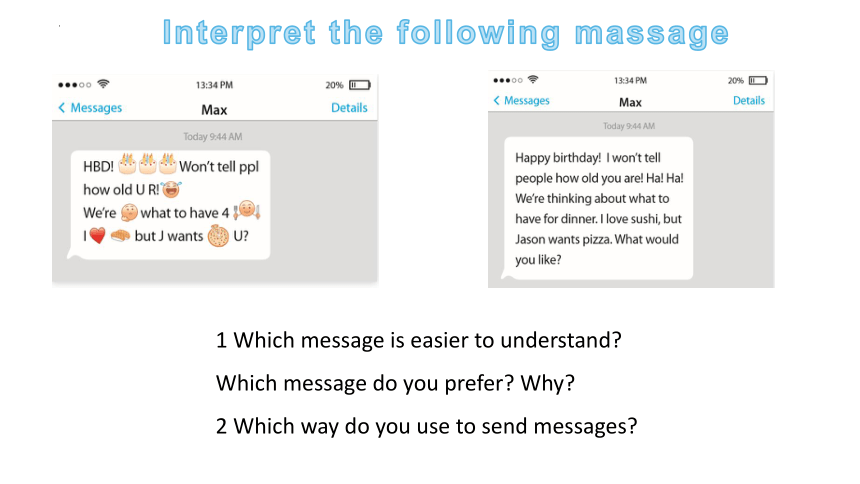
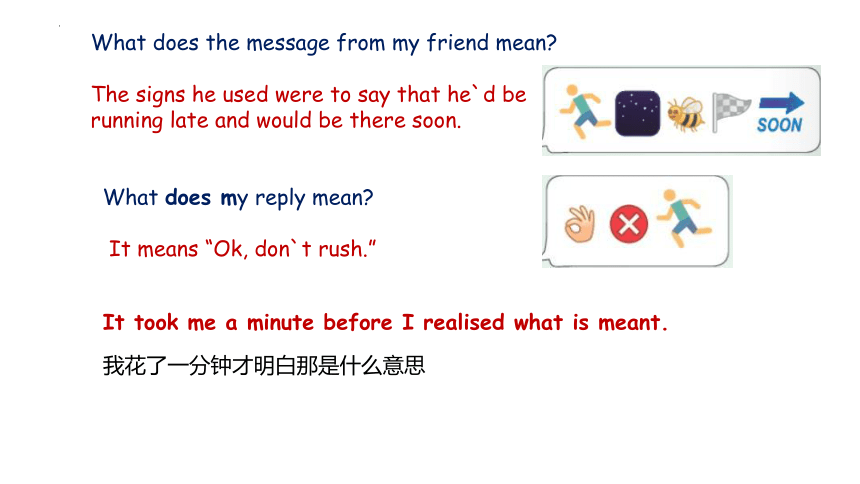
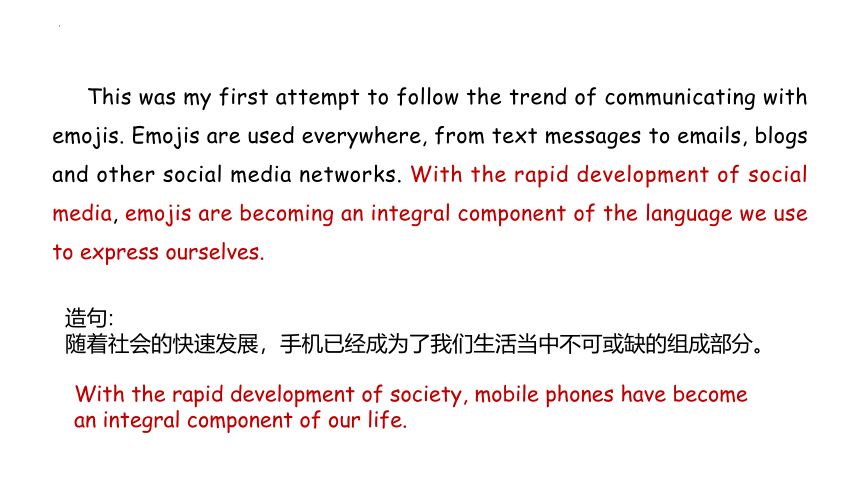

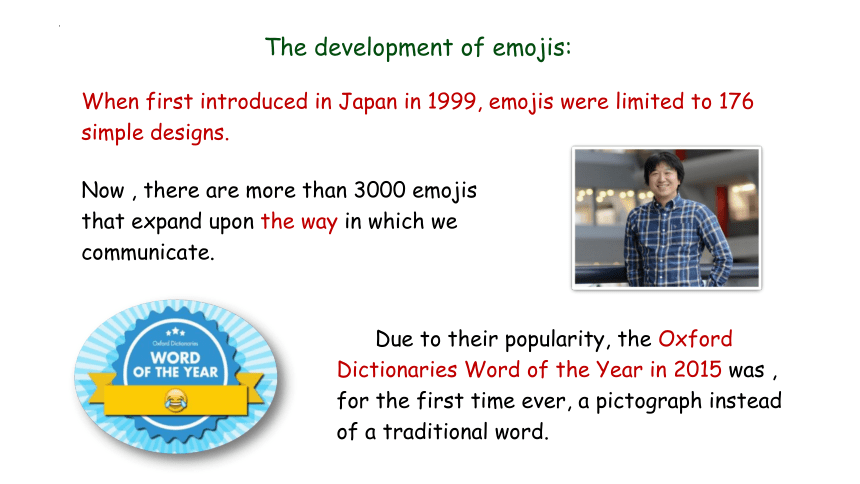
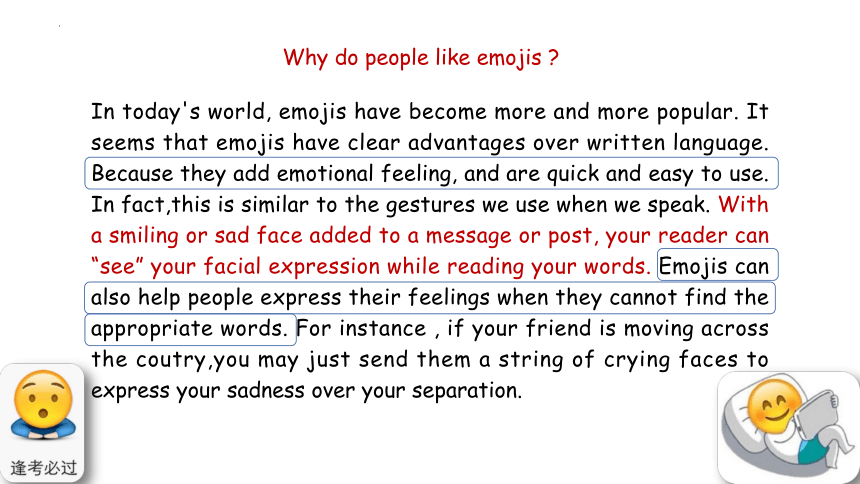
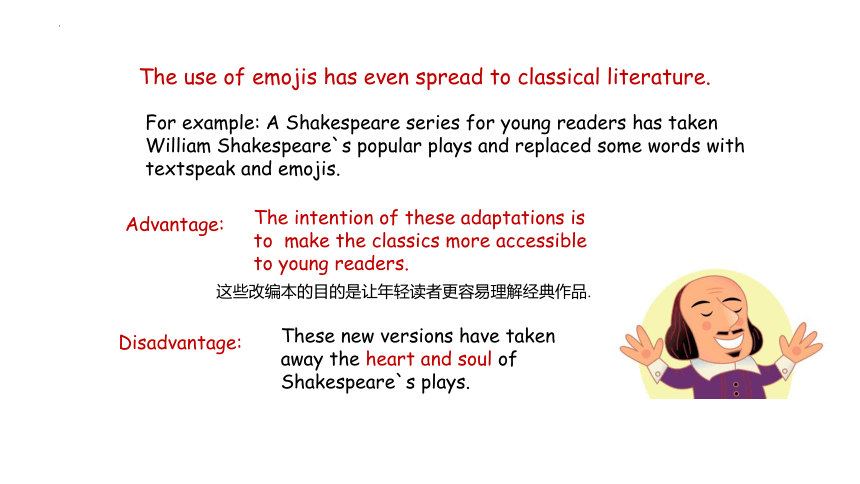

文档简介
(共20张PPT)
Emojis: a new language
Unit 3 Times change
1 Which message is easier to understand Which message do you prefer Why
2 Which way do you use to send messages
Interpret the following massage
What does the message from my friend mean
The signs he used were to say that he`d be running late and would be there soon.
What does my reply mean
It means “Ok, don`t rush.”
It took me a minute before I realised what is meant.
我花了一分钟才明白那是什么意思
This was my first attempt to follow the trend of communicating with emojis. Emojis are used everywhere, from text messages to emails, blogs and other social media networks. With the rapid development of social media, emojis are becoming an integral component of the language we use to express ourselves.
造句:
随着社会的快速发展,手机已经成为了我们生活当中不可或缺的组成部分。
With the rapid development of society, mobile phones have become an integral component of our life.
What does the word “emoji” come from and what are “emojis”
The word “emoji” comes from Japanese , literally meaning “ picture character”. Emojis are small symbols representing ideas, emotions or feelings. They come in
different categories, such as faces
and people, plants and animals, and
food and drink.
按照字面上地
The development of emojis:
When first introduced in Japan in 1999, emojis were limited to 176 simple designs.
Now , there are more than 3000 emojis that expand upon the way in which we communicate.
Due to their popularity, the Oxford Dictionaries Word of the Year in 2015 was , for the first time ever, a pictograph instead of a traditional word.
In today's world, emojis have become more and more popular. It seems that emojis have clear advantages over written language. Because they add emotional feeling, and are quick and easy to use. In fact,this is similar to the gestures we use when we speak. With a smiling or sad face added to a message or post, your reader can “see” your facial expression while reading your words. Emojis can also help people express their feelings when they cannot find the appropriate words. For instance , if your friend is moving across the coutry,you may just send them a string of crying faces to express your sadness over your separation.
Why do people like emojis
The use of emojis has even spread to classical literature.
Advantage:
For example: A Shakespeare series for young readers has taken William Shakespeare`s popular plays and replaced some words with textspeak and emojis.
The intention of these adaptations is to make the classics more accessible to young readers.
Disadvantage:
These new versions have taken away the heart and soul of Shakespeare`s plays.
这些改编本的目的是让年轻读者更容易理解经典作品.
Emojis `s future
One day, perhaps emojis will have become a real pictorial “language”.
Emojis have a tendency to pop up all over the place. Users of emojis say that they facilitate the way in which we communicate and express ourselves. But this makes others, especially educators, worry that we are losing the ability to communicate properly using the written word, or even the spoken word.
Concerns:
After all, how many of us today would rather send a message packed with emojis than make a telephone call
Reason:
The structutre of the text
Parts paragraghs the main ideas
Part 1 Para 1,2,3
Part 2 Para 4,5,6,7
Part 3 Para 8
My attempt to follow the trend of communicating with emojis
The origins and development of emojis and the application of emojis in daily life.
the future development ad educators' worry about the negative effect on our traditional languages.
Choose the author's purpose in writing the passage
A. To guide readers to use emojis properly.
B. To discuss the development and influence of emojis.
C. To criticize the increased use of emojis.
D. To entertain readers with examples of how emojis have been used.
Suggested answer: _______
B
Give your reasons for the choice:
The author introduces the topic of emojis through examples, then introduces the origin and development of emojis, and explains the application of emojis in daily life. Finally, the article discusses the future development of emojis. We can see that the author intends to discuss the development and influence of emojis.
1 Where does the word “emoji”come from
A Chinese B English C Japanese D French
2 Emojis come in different categories except_____________.
A faces and people B plants and animals
C food and drink D traditional English words
3 People like emojis mainly because______________.
A they are funny
B they add emotional meaning, and are quick and easy to use
C they can express your idea more clearly
D all of them can reflect classical literature
4 Which of the following is right according to the passage
A Emojis were first introduced in Japan in 1999.
B Now there are 16000 emojis in all.
C Emojis have replaced written words in people`s daily life.
D All people are in favour of using emojis in the adaptation of the classics.
Reading comprehension
Decide the following statement is Ture (T) ot False (F)
1. The author uses emojis for communicating with friends from text messages to emails, blogs and other socail media networks. ( )
2. The emojis are used in English more often than in Japanese. ( )
3. Emojis, as a new language, have clear advantages over traditional languages, including writing and speaking. ( )
4. Classical literature is suggested to use words with textspeak and emojis instead of traditional languages. ( )
5. Some educators worry about the negative effect on our traditional langauges. ( )
F
F
F
F
T
The word “emoji” comes from Japanese, literally 1________(mean) “ picture character”. Emojis are small symbols representing ideas, emotions or feelings. They come in 2___________(differ) categories, such as faces and people, plants and animals, and food and drink.
When first 3_________(introduce) in Japan in 1999, emojis were limited to 176 simple design. Now there are more than 3000 emojis that expand 4________ the way in which we communicate. In today`s world, emojis have become more and more popular. 5_____ seems that emojis have clear advantages over 6__________(write) language. People like them because they add emotional meaning, and easy 7________(use). As we can see, emojis have a 8_________(tend) to pop all over the place. 9_____ some users, especially educators, worry that we 10_________(lose)the ability to communicate properly using the written word, or even the spoken word.
meaning
different
introduced
on/upon
It
written
to use
tendency
But
are losing
直击高考
Guess the meanings of abbreviations for chatting online
u = __________
2day = __________
thx= __________
b4 = ____________
msg= __________
gre8 = __________
@= ____________
cuz = ___________
2moro= _________
k = ____________
plz= __________
l8r = ____________
you
thanks
message
at
tomorrow
please
today
before
great
because
OK
later
Writing about a change
描写变化
本单元写作项目是描写变化的文章,属于说明文的写作范畴。
【基本框架】
1.开头(the beginning) ——总体描述;
2.主体(the middle) ——具体描述;
3.结尾(the ending) ——阐述自己观点/看法。
Writing about a change
【常用词块】
1.great changes have taken place
2.during the last few years
3.attract more travellers
4.be covered with green trees
5.do harm to environment
发生了巨大变化
在过去的几年里
吸引更多的游客
被绿树覆盖
破坏环境
我的学校在过去十年里发生了翻天覆地的变化。
随着科技的迅速发展,我们的生活质量正在提高。
过去,人们主要通过写信或公用电话保持联系。
更重要的是,人们可以方便地访问互联网,这使得他们可以随时收发电子邮件。
Writing about a change
【常用语句】
1.Great changes have taken place in my school over the past ten years.
我的学校在过去十年里发生了翻天覆地的变化。
2.With the rapid development of science and technology, the quality of our lives is improving.
随着科技的迅速发展,我们的生活质量正在提高。
Writing about a change
【常用语句】
3.In the past, people kept in touch with each other mainly by writing letters or using the public telephone.
过去,人们主要通过写信或公用电话保持联系。
4.What's more, people can easily have access to the Internet, which enables them to send and receive e mails at any time.
更重要的是,人们可以方便地访问互联网,这使得他们可以随时收发电子邮件。
Emojis: a new language
Unit 3 Times change
1 Which message is easier to understand Which message do you prefer Why
2 Which way do you use to send messages
Interpret the following massage
What does the message from my friend mean
The signs he used were to say that he`d be running late and would be there soon.
What does my reply mean
It means “Ok, don`t rush.”
It took me a minute before I realised what is meant.
我花了一分钟才明白那是什么意思
This was my first attempt to follow the trend of communicating with emojis. Emojis are used everywhere, from text messages to emails, blogs and other social media networks. With the rapid development of social media, emojis are becoming an integral component of the language we use to express ourselves.
造句:
随着社会的快速发展,手机已经成为了我们生活当中不可或缺的组成部分。
With the rapid development of society, mobile phones have become an integral component of our life.
What does the word “emoji” come from and what are “emojis”
The word “emoji” comes from Japanese , literally meaning “ picture character”. Emojis are small symbols representing ideas, emotions or feelings. They come in
different categories, such as faces
and people, plants and animals, and
food and drink.
按照字面上地
The development of emojis:
When first introduced in Japan in 1999, emojis were limited to 176 simple designs.
Now , there are more than 3000 emojis that expand upon the way in which we communicate.
Due to their popularity, the Oxford Dictionaries Word of the Year in 2015 was , for the first time ever, a pictograph instead of a traditional word.
In today's world, emojis have become more and more popular. It seems that emojis have clear advantages over written language. Because they add emotional feeling, and are quick and easy to use. In fact,this is similar to the gestures we use when we speak. With a smiling or sad face added to a message or post, your reader can “see” your facial expression while reading your words. Emojis can also help people express their feelings when they cannot find the appropriate words. For instance , if your friend is moving across the coutry,you may just send them a string of crying faces to express your sadness over your separation.
Why do people like emojis
The use of emojis has even spread to classical literature.
Advantage:
For example: A Shakespeare series for young readers has taken William Shakespeare`s popular plays and replaced some words with textspeak and emojis.
The intention of these adaptations is to make the classics more accessible to young readers.
Disadvantage:
These new versions have taken away the heart and soul of Shakespeare`s plays.
这些改编本的目的是让年轻读者更容易理解经典作品.
Emojis `s future
One day, perhaps emojis will have become a real pictorial “language”.
Emojis have a tendency to pop up all over the place. Users of emojis say that they facilitate the way in which we communicate and express ourselves. But this makes others, especially educators, worry that we are losing the ability to communicate properly using the written word, or even the spoken word.
Concerns:
After all, how many of us today would rather send a message packed with emojis than make a telephone call
Reason:
The structutre of the text
Parts paragraghs the main ideas
Part 1 Para 1,2,3
Part 2 Para 4,5,6,7
Part 3 Para 8
My attempt to follow the trend of communicating with emojis
The origins and development of emojis and the application of emojis in daily life.
the future development ad educators' worry about the negative effect on our traditional languages.
Choose the author's purpose in writing the passage
A. To guide readers to use emojis properly.
B. To discuss the development and influence of emojis.
C. To criticize the increased use of emojis.
D. To entertain readers with examples of how emojis have been used.
Suggested answer: _______
B
Give your reasons for the choice:
The author introduces the topic of emojis through examples, then introduces the origin and development of emojis, and explains the application of emojis in daily life. Finally, the article discusses the future development of emojis. We can see that the author intends to discuss the development and influence of emojis.
1 Where does the word “emoji”come from
A Chinese B English C Japanese D French
2 Emojis come in different categories except_____________.
A faces and people B plants and animals
C food and drink D traditional English words
3 People like emojis mainly because______________.
A they are funny
B they add emotional meaning, and are quick and easy to use
C they can express your idea more clearly
D all of them can reflect classical literature
4 Which of the following is right according to the passage
A Emojis were first introduced in Japan in 1999.
B Now there are 16000 emojis in all.
C Emojis have replaced written words in people`s daily life.
D All people are in favour of using emojis in the adaptation of the classics.
Reading comprehension
Decide the following statement is Ture (T) ot False (F)
1. The author uses emojis for communicating with friends from text messages to emails, blogs and other socail media networks. ( )
2. The emojis are used in English more often than in Japanese. ( )
3. Emojis, as a new language, have clear advantages over traditional languages, including writing and speaking. ( )
4. Classical literature is suggested to use words with textspeak and emojis instead of traditional languages. ( )
5. Some educators worry about the negative effect on our traditional langauges. ( )
F
F
F
F
T
The word “emoji” comes from Japanese, literally 1________(mean) “ picture character”. Emojis are small symbols representing ideas, emotions or feelings. They come in 2___________(differ) categories, such as faces and people, plants and animals, and food and drink.
When first 3_________(introduce) in Japan in 1999, emojis were limited to 176 simple design. Now there are more than 3000 emojis that expand 4________ the way in which we communicate. In today`s world, emojis have become more and more popular. 5_____ seems that emojis have clear advantages over 6__________(write) language. People like them because they add emotional meaning, and easy 7________(use). As we can see, emojis have a 8_________(tend) to pop all over the place. 9_____ some users, especially educators, worry that we 10_________(lose)the ability to communicate properly using the written word, or even the spoken word.
meaning
different
introduced
on/upon
It
written
to use
tendency
But
are losing
直击高考
Guess the meanings of abbreviations for chatting online
u = __________
2day = __________
thx= __________
b4 = ____________
msg= __________
gre8 = __________
@= ____________
cuz = ___________
2moro= _________
k = ____________
plz= __________
l8r = ____________
you
thanks
message
at
tomorrow
please
today
before
great
because
OK
later
Writing about a change
描写变化
本单元写作项目是描写变化的文章,属于说明文的写作范畴。
【基本框架】
1.开头(the beginning) ——总体描述;
2.主体(the middle) ——具体描述;
3.结尾(the ending) ——阐述自己观点/看法。
Writing about a change
【常用词块】
1.great changes have taken place
2.during the last few years
3.attract more travellers
4.be covered with green trees
5.do harm to environment
发生了巨大变化
在过去的几年里
吸引更多的游客
被绿树覆盖
破坏环境
我的学校在过去十年里发生了翻天覆地的变化。
随着科技的迅速发展,我们的生活质量正在提高。
过去,人们主要通过写信或公用电话保持联系。
更重要的是,人们可以方便地访问互联网,这使得他们可以随时收发电子邮件。
Writing about a change
【常用语句】
1.Great changes have taken place in my school over the past ten years.
我的学校在过去十年里发生了翻天覆地的变化。
2.With the rapid development of science and technology, the quality of our lives is improving.
随着科技的迅速发展,我们的生活质量正在提高。
Writing about a change
【常用语句】
3.In the past, people kept in touch with each other mainly by writing letters or using the public telephone.
过去,人们主要通过写信或公用电话保持联系。
4.What's more, people can easily have access to the Internet, which enables them to send and receive e mails at any time.
更重要的是,人们可以方便地访问互联网,这使得他们可以随时收发电子邮件。
